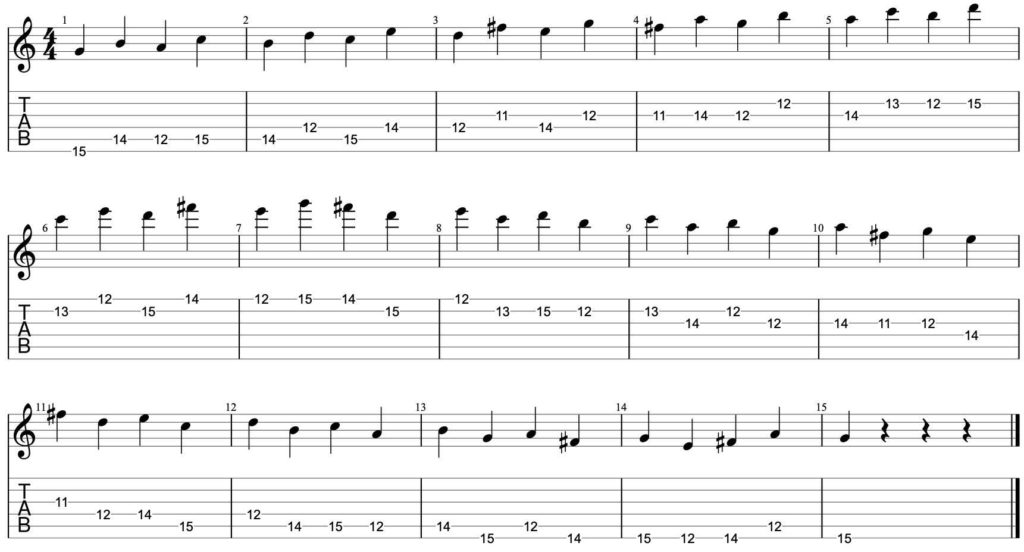March 25, 2020 by Klaus Crow

I hope you are doing okay with everything that is going on now. These are crazy times, but we have to make the best of it. We have to help each other out while keeping a safe distance, be considerate of others, smile to people to relieve a bit of their burden, but with all that don’t forget yourself along the way. Being kind to yourself too. Have a bit of fun. Try to enjoy the present moment.
For those of you who stay at home, you might have some more time on your hands now to enjoy the guitar, develop a nice practice routine, and make some good progress. Well, here’s a great guitar workout for you…
Practicing melodic intervals really developed my skills to solo and improvise over major chord progressions. Just by going through the scale intervals on a regular basis you are training the muscle memory for your fingers and acquiring the vocabulary for your creative mind to help you shape your musical brain and come up with melodic ideas. It’s an exercise that is not to be underestimated.
In this lesson we are going to learn “melodic intervals in 3rds” following the major scale. We’ll practice these 3rd intervals over 5 different scale shapes/positions across the neck, so we’ve got a great workout for you! Don’t worry we’ll take it step by step.
Make sure you know the major scale in 5 shapes/positions before you start this lesson, but on the other hand you can also skip that for now if you just became excited to dive into this lesson. You can always come back to that later. I can imagine you want to try at least the first exercise to know what we’re talking about here. I totally understand.
Another upside is that the exercises will train your ear to recognize 3rd intervals. This will improve your aural skills, which is a important part of becoming an accomplished musician (Try to sing along the notes as you play the exercises). The practice of playing the intervals will also increase your dexterity. A win-win situation in many ways.
Music Theory 3rd Intervals
If you don’t like music theory you can skip this part, but you might pick up a thing or two that will eventually make you an awesome guitar player. I’ll keep it short this time.
An interval is the difference in pitch between two sounds. There are harmonic intervals and melodic intervals. Harmonic intervals are played simultaneously (two notes played together at the same time) and melodic intervals are played in sequence, one after the other. In this lesson we play melodic intervals.
For example we use the G major scale in 5 different shapes/positions. The G major scale consists of the notes : G A B C D E F# G. If you play a scale in thirds it means each note in the scale is followed by the third note in that scale. The first note G follows up by the third note B, then you play the second note of the scale A which follows up by a C and so on. So you get the notes: G-B, A-C, B-D, C-E, D-F#, E-G, G-B. These are a combination of major thirds and minor thirds, but before I get totally sidetracked I’ll go into that in another lesson. Promise! Now let’s focus on the practice.
How to Practice the Major Scale in 3rds
We all have different skill levels (beginner, intermediate, advanced) so I suggest you start with practicing the first shape / position 1. Practice it slowly. Make sure all the notes sound clean and clear. Memorize each exercise thoroughly and learn the scale ascending and descending.
Move on to the next shape when you can play the first shape comfortably and confidently off the top of your head. If you’re a beginner just learn the first shape/position 1. If you’re an intermediate or advanced guitar player you can learn all shapes, but take your time with it. Let it sink in. Become one with it. Enough said…
Enjoy the ride!
Major scale 3rd intervals – Shape / Position 1

Major scale 3rd intervals – Shape / Position 2

Major scale 3rd intervals – Shape / Position 3

Major scale 3rd intervals – Shape/Position 4

Major scale 3rd intervals – Shape / Position 5

Awesome article! Thank you for sharing this amazing content. This information genuinely helped me a lot. I always admire your way of writing, it is truly stunning and keeps sharing such valuable information.
thanks a lot
Hi! Curious about fingering for position 2, especially concerning when to move up or a down a fret and which fingers to pivot with.
Could you add fingering to these diagrams? Thanks so much!
Good stuff. Instruction very easy to understand .